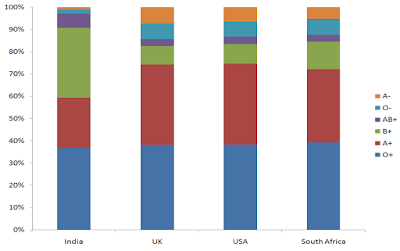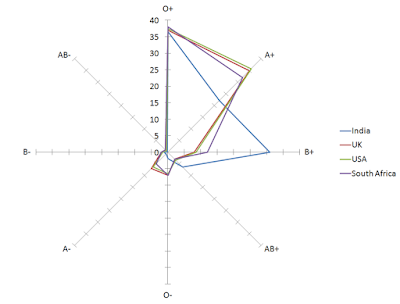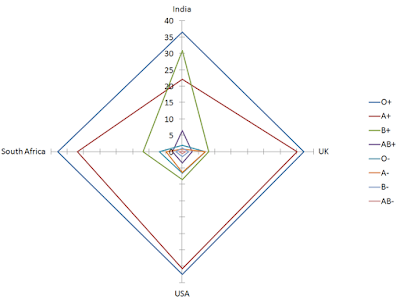
In this post, we shall look at how to visualize this data to get the maximum information. A regular reader of this blog Riz Mathani commented on the last post with this option. His solution is simple:
Go to MS PowerPoint -> Insert Chart -> Choose 100% Stacked Column Chart (also called the Stacked Bar Chart). Use this type of chart when breaking down data into parts and comparing the parts. In our table, we are breaking down blood groups into 8 parts and then comparing them.
This is how the chart will look like:
 This I feel is the simplest way (and often the best way) to show such a piece of data. Some quick conclusions we can make from this chart are:
This I feel is the simplest way (and often the best way) to show such a piece of data. Some quick conclusions we can make from this chart are:1. O+ is the most common blood group across all countries
2. A+ is relatively less common in India when compared to other countries
3. India is the only country with a very high B+ percentage
4. O+, A+ and B+ together form the most common blood groups in these countries.
There is however another way this data can be looked at. You must try using this chart and if you feel comfortable using it. I am talking about a Radar Chart.
Insert Chart -> Radar -> Radar (without markers). Here is the output:

To change the view select the chart -> Under Chart Tools -> Design Tab -> Switch Row/Column (in MS PowerPoint 2007). This is the final result:

This data clearly shows that O+ is the most common blood group followed by A+. B+ is very high in India and relatively low in other countries. Radar chart is very good at showing aberrations/outliers (like the B+ in India's case). If values are very similar to each other, avoid Radar Charts.
These were two solutions to this problem; one from Riz and I from me. Do you have any other way of visualising this data?
No comments :
Post a Comment